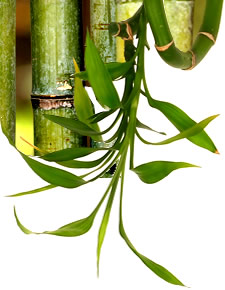

Bamboo Biology |
The stems, or 'culms', can range in height from a few centimetres to 40 metres, with stem diameters ranging from 1 mm to 30 cm. The stems are jointed, with regular nodes; each node bears one leaf, and may also have one to several side branches. They are thus, unlike most other grasses, extensively branched; in large-growing species a single stem may carry many thousands of branchlets. Many of the larger bamboos are very tree-like in appearance, but perhaps illogically they are rarely called trees, despite that term being a growth form, not a botanical term. For comparison, palms, which like bamboos are monocotyledons, are equally dissimilar to other trees, yet are usually called trees. A single stem of bamboo from an established root system typically reaches full height in just one year, but then persists for several years, gradually increasing the number of side branches and branchlets. Some species of bamboo rarely flower, some of them only every 10-100 or more years. Some of these species are monocarpic, the plant dying after the seed matures. Furthermore, all the individuals of the species will flower at the same time in a large geographical region. This is thought to have evolved to reduce the effect of predators of the seed, who would be unable to depend on a predictable food supply. |
© Copyright yayixm.com All rights reserved. Unauthorized duplication in part or whole strictly prohibited by international copyright law. |
|
|